Degtyarev infantry
During the First World War, there was a clear differentiation of small arms according to their tasks. One of the main factors for increasing the firepower of infantry became machine guns. The Red Army until the middle of the 1920-s did not have such weapons of domestic design. On its arms continued to consist of foreign models of light machine guns, remaining from the Russian imperial army or trapped during the Civil War: including 8-mm French Shosh M.1915 and Hotchiss M.1909 ,.303 (7,71-mm) , English by Lewis M.1915. The few outdated and almost completely worn out light machine-guns, and even foreign-made cartridges of different types, required urgent replacement.
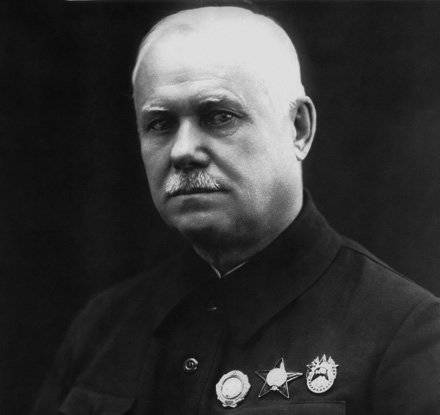
The development of an own model of a light machine gun in completely destroyed Soviet Russia, in the absence of the necessary production base and without any significant engineering groundwork, was very difficult. Although to solve this problem, the construction of the Kovrov machine-gun factory, which was intended for the licensed production of the Danish 1916-mm Madsen light machine gun, began in Russia, but the civil war and the ensuing devastation did not allow for the mass production of automatic weapons until the end of 8 -y's
The first contribution of V. A. Degtyarev to the rearmament of the Red Army with a new automatic weapon was the creation of a light machine gun.
After the end of the Civil War, the well-known Russian gunsmiths began to work on the problem of designing a new type of weapon in the design bureau of the Kovrov arms factory (in the 1930–1940s called “State Union Plant No. 2 named after K. O. Kirkizh”) V. G. Fedorov and his student - V. A. Degtyarev. Soon, the plant’s design bureau became a genuine school for the scientific development and development of the production of the latest automatic weapons systems, and the plant itself was one of the centers for creating small arms and aircraft weapons. Within the walls of the Kovrov Plant, Fedorov and Degtyarev put into practice the idea of unification of small arms - the creation on the basis of the basic design of various types of weapons with a single principle of automation. However, their first approach to solving the problem was to develop on the basis of the Fedorov assault rif. 1916 a whole complex of weapons of 6,5 mm caliber, which included a light machine gun, manual, aviation и tank machine guns turned out to be unsuccessful. Such a sad outcome was influenced by two circumstances - the very design of the weapon and the use in it of a foreign 6,5 mm Japanese rifle cartridge.
As it turned out impossible to quickly create their own design of a manual machine gun, experts of the Artcom Chief Artillery Directorate (GAU) found, as they thought, the simplest solution to the current situation by reworking the standard Maxim machine gun into manual ones, which promised to give a gain in time in production and technical and financial relations. Although it was initially clear: this measure is only temporary, since the experience of the First World War convincingly proved that this design, while retaining the complexity of the easel machine gun, was deprived of its main advantage - simplicity and low weight.
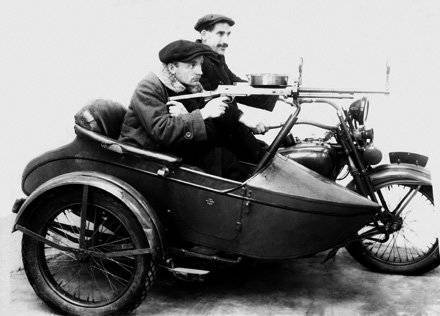
In 1923, the creation of a light machine gun was entrusted to I. N. Kolesnikov and F. V. Tokarev. Due to the stringent requirements of the tactical and technical tasks, their samples were generally quite similar, but after numerous tests, the Tokarev machine gun was preferred. He was commissioned by the Red Army under the designation "7,62-mm Maxim-Tokarev (MT) light machine gun." Unlike its prototype, it had an air-cooling casing, a bipod, a wooden butt to which was attached a brace with a trigger mechanism and a safety device. The new weapon in comparison with the Maxim machine gun was much easier and more maneuverable. However, from the very beginning there were major flaws in its design, which subsequently influenced the further fate of the machine gun: a large mass (along with cartridges - 23 kg), considerable length, which caused inconvenience in operation, especially when carried on the march, a lot of delays when shooting, unsuccessful power system, leading to poor tape feed, difficulty replacing a heated barrel. However, the hopelessness of the situation with manual machine guns in the Red Army demanded the speedy start-up of even such a model. Therefore, in the 1926 – 1927 years, the Tula Arms Factory produced the 2450 Maxim-Tokarev machine guns, the 1925 of the year.
Despite the adoption of the Tokarev light machine gun, the problem did not disappear. The troops needed a simpler design, less overall and at the same time light machine gun, which could be used for direct infantry fire support on the battlefield. It was necessary to create a special light machine gun, which absorbed all the latest achievements of science and production.
Acutely feeling the need of the army for this kind of weapon, many Soviet gunsmiths began to design it proactively. Among them were representatives of the Kovrov plant: V. A. Degtyarev (back in 1924, he offered his first prototype to the Artillery Committee of the GAU), and S. G. Simonov, who took on similar work a year later. In 1926, Degtyarev presented his modified model for competitive tests, which proved obvious advantages over the Maxim-Tokarev machine gun mod. 1925 of the year.
The prototype of the Degtyarev 1926 machine gun of the year, designed for firing regular 7,62-mm rifle and machine-gun cartridge of the 1908 model of the year, in relation to the other models of this weapon that was much easier, easier to handle, and most importantly - simpler in design, than the recently adopted sample Maxim-Tokarev. Numerous factory and field tests revealed the superiority of the machine gun designed by V. A. Degtyarev, and some of its drawbacks were noted.
The machine guns were returned to the designer to refine and eliminate the noted deficiencies, and it was proposed that 10 of January 1927 of the year be submitted for final testing.
Degtyarev introduced some improvements into his machine gun: he increased the strength of the bolt carrier, the thickness of the ribs at the handle and the sleeve window, changed the shape of the striker’s striker head, which in general affected their strength. 17 – 21 January 1927, the commission of the Artillery Committee directly at the plant tested two machine guns with these changes. The machine guns were made on 20 thousands of shots. One machine gun gave 0,5% delays, the other 0,3%. From the strong heating during continuous firing in both machine guns the gas chamber nozzles burned, the ejector hooks crumbled, and in the second machine gun, in addition, the spring of the ejector broke off and the return spring burst.
Summing up the tests, the commission came to the following conclusion: “Taking into account the insignificant percentage of delays (0,3 – 0,5%), as well as the fact that the 40 had thousands of shots made during the present test, the number of different failures turned out to be minimal, and can be seen from the above explanation, they can not excite special hazards in relation to the strength of the machine gun, the commission believes it is possible to present both machine guns as samples for all preliminary work on the installation of production. "
In December, the improved version under the designation “Degtyarev Infantry (PD)” was last tested by a special committee of the Revolutionary Military Council in very harsh and unfavorable conditions: under thirty degrees of frost. Weapons showed good results. In the same month, it was adopted by the Red Army under the designation "1927-mm light machine gun Degtyarev infantry."
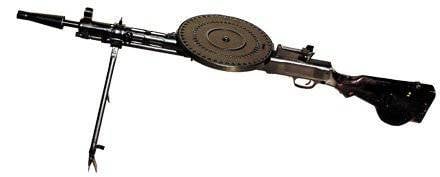
The 7,62-mm DP manual machine gun was the main automatic weapon of the rifle squad. His combat mission is to defeat open and camouflaged group and important single living targets at distances up to 800 m and defeat storming aircraft and descending paratroopers at ranges up to 500 m. at distances to 300 m. Fire from a manual DP machine gun was conducted, as a rule, in short bursts (3 – 6 shots). The rate of fire reached 600 rounds per minute. Combat rate was up to 80 shots per minute. The weight of a light machine gun DP with a bipod - 8,4 kg; weight of the 47 charging magazine with cartridges - 2,8 kg. The sighting range of the machine gun was 1500 m; ultimate range of a bullet arr. 1908 g. - up to 3 km. In battle, Degtyarev's light machine gun was served by two fighters.
The automatics of the DP manual machine gun worked on the principle of removal of powder gases from the barrel, locking was carried out by diluting to the sides of the lugs. This design feature later became a trademark of the card, embodied in almost all machine guns V. A. Degtyarev.
Impact mechanism shock type. The trigger mechanism is designed only for continuous fire. The automatic type fuse, located behind the trigger bracket, was simultaneously its emphasis. To start the shooting, the machine gunner, covering the neck of the butt with his hand, simultaneously turned off the fuse, thereby instantly bringing the weapon into a fighting position. Automatic shooting continued as long as the trigger was pulled and the magazine had ammunition. When the trigger was released, the combat platoon of the departed frame dropped behind the sear of the raised trigger lever, the frame stopped in the rear position and the shooting stopped, but the machine gun remained charged.
Rationally solved scheme of automation, significantly smaller dimensions of the receiver compared to other machine guns of the time, which was achieved using a sliding bolt and direct feed of ammunition from the magazine, as well as a well-thought-out layout of mobile systems reduced the total weight of the weapon.
The concept of the machine gun Degtyarev was as follows.
When fired, the powder gases, expanding, pushed the bullet forward, and the sleeve back. The sleeve under the pressure of gases tightly pressed against the cap of the bolt. The shutter could not move back, as the battle stops were divorced and rested against the military ledges of the receiver.
The bullet under the pressure of gases, crashing into the grooves of the barrel, moved forward. When the bullet passed through the gas outlet in the barrel, some of the powder gases that followed the bullet rushed into the gas chamber and, acting on the piston, threw it back. The bolt carrier, rigidly connected to the piston rod, also moved back, dragging the drummer and compressing the return-action spring.
When the bolt carrier passed the path in 15 mm, the thickened part of the hammer went out of the channel of the gate skeleton back and made it possible for the lugs to disengage from the receiver. The disengagement of the lugs with the receiver and their reduction occurred as a result of the interaction of the bevels of the slide gate frame and the corresponding projections on the lugs.
The shutter, reaching the breech of the breech, stopped, and the bolt carrier together with the drummer continued to move forward. The thickened part of the drummer parted the lugs that went into the ledges in the receiver, which was achieved by firmly locking the barrel at the time of the shot.
The positive features of the new weapon were the simplicity of the machine gun, which consisted of 47 parts and parts, which was influenced by the original design of the locking and firing mechanisms. Moreover, some of the moving parts of the automation combined several functions at the same time, in particular, they included a slide frame and a drummer. The thoughtful layout of these parts greatly facilitated the maintenance and operation of the machine gun. The ability to change the amount of powder gases acting on the movable automation system was achieved by regulating the gas chamber, which was an important factor when the weapon was operating under adverse operating conditions: during contamination, dusting, and extreme temperatures. Aim shooting was carried out from a machine gun on group and single targets at a distance of 800 m. A sliding bipod landing ensured a stable position of the machine gun during firing, affecting good accuracy of the battle. So, when shooting from the DP on the 100 distance m in short bursts of growth targets, the dispersion did not exceed 40 cm, which was a good indicator.
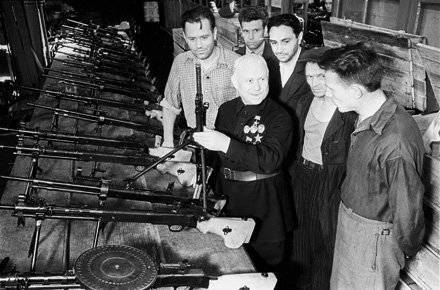
Noting the personal merits of V. A. Degtyarev and the exceptional importance of the light machine gun as the firstborn of the Soviet automatic weapons in strengthening the country's defense, the People's Commissar K. Ye. Voroshilov in his speech in 1935 before the troops of the Moscow Garrison said: other designers the main role of the designer Degtyarev. V. A. Degtyarev owes much to the army. ” By this time, DP manual machine guns had taken a firm place in the weapons system of the Red Army and their release basically met the needs of the troops.
In the pre-war years, Degtyarev, in close cooperation with the designers of PKB, is very much and fruitfully working on the modernization of the PD and the creation of qualitatively new designs of light machine guns. For all, without exception, samples of weapons designed by V. A. Degtyarev, one feature is characteristic: their automation worked on the principle of removing powder gases from the barrel. At the same time, many models of manual machine guns had their own individual characteristics. Thus, the prototypes of the Degtyarev light machine gun, the 1928 model of the year and the 1930 model of the year, had an air cooling of the Lewis-type barrel, a reciprocating combat spring transferred to the butt, and two types of power supply systems - in the 1928 model of the year - a disk magazine with three-row 63 cartridges, and in the 1930 model of the year - a receiver for a metal hinged link belt of the Hotchiss M.XNXX type.
Simultaneously with these works, the design of machine tools for the DP manual machine gun was carried out. Initially it was planned to equip it with a light tripod machine from the English Lewis M. 1914 machine gun, but its main drawback - the ability to fire only at ground targets - did not allow to give universal functions to this weapon, which significantly limited its capabilities.
In 1936, a modernized DPM-36, developed in the style of the Czechoslovak light machine gun ZВ-26, appears. Its characteristic features included: a sector magazine on 30 of cartridges, mounted on top of the receiver, a returnable spring loaded into the butt, and a quick-change barrel, as well as two types of lightweight universal alarming machines designed by I. I. Bezrukov and I. N. Kolesnikova , which allowed to turn the PD and the DPM-36 in the machine gun or anti-aircraft machine gun. In the same year, another very interesting sample of the Degtyarev airborne assault machine gun appeared, which differed from the previous model by locking it with one combat larva, reloading handle, made in the form of a rifle bar, and the possibility of attaching the blade bayonet. The mass of the assault machine gun was only 7 kg with a total length of 1050 mm. To this machine gun, Degtyarev designed a lightweight universal tripod machine for amphibious operations of a very simple design, with a mass of 7,5 kg. Subsequently, this machine was adapted and under the standard DP.
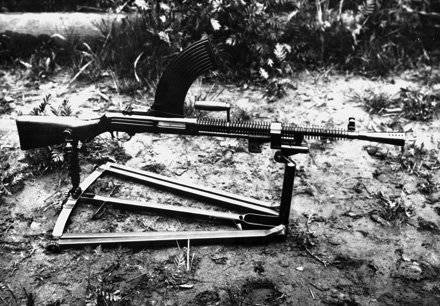
Along with the creation of new original models, Kovrov gunsmiths in 1936 – 1939 tried to adapt to the regular DP a variety of tape and store supply systems, including removable receivers: under the cloth tape of Maxim machine-gun; under the rigid metal cassette type "Hotchkis." In the 1938 – 1939 years after the end of the fighting on Lake Hassan and the Khalkhin-Gol river, Soviet troops took a large quantity of weapons as trophies and among them various samples of Japanese machine guns. The engineers made a number of attempts to implement some rather peculiar constructive elements in the Degtyarev light machine gun. In particular, in 1939, the designers of Kubynov and Razorenov create a detachable receiver for a standard DP on 25 rifle cartridges in cages, like the Japanese light machine gun type 11 (sample 1922 of the year). However, too much complexity in the manufacture of the receiver and the insecurity of its operation forced to abandon such technical innovations.
The most promising development of the prewar years was the Degtyarev light machine gun, a prototype of the 1939 of the year (DP-39). In this model, Degtyarev tried to fully implement the idea of unifying various models of small arms. In its design, many elements of both the DP manual machine gun and the DS-39 machine gun were quite organically combined. The new weapon had many standardized units and parts with the DS-39 machine gun (receiver, receiver for a metal belt, trigger mechanism), which planned to rearm all units of the Red Army. Such a unification of light and heavy machine guns made it possible to simplify and cheapen their production, to facilitate the study in the army, significantly reducing the costs of operating a weapon.
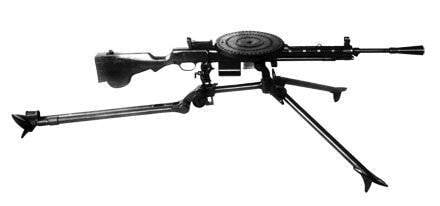
Shortly before the Great Patriotic War, the Soviet government decided to expand the mass production of the DP at a backup plant in order to ensure an uninterrupted supply of the Red Army with light machine guns in case of danger to the main weapons factory in Kovrov. Therefore, already in 1940, the release of DP manual machine guns was also mastered by an enterprise in the city of Stalinsk of the Altai Territory.
By the beginning of World War II, the factories in Kovrov and Stalinsk launched more than 200 000 light machine guns of the Degtyarev design. Since June 1941, their production has been developing at an ever-accelerating pace.
During the Great Patriotic War, the design of the DP was repeatedly reviewed by technologists, which made it somewhat easier by switching to the production of some parts by stamping. The colossal needs of the army in this simple and reliable weapon contributed to the establishment of its release from the 1943 year in the besieged Leningrad at the Arsenal plant to them. MV Frunze, which lasted until the end of World War II.
Thanks to a simple device, reliability of action, accuracy of shooting and high maneuverability, the DP with honor served the Soviet soldier for more than twenty years, being the main automatic weapon of infantry fire support in the platoon level. In just four years of war, Soviet gunsmiths transferred to the front a little more than 660 000 DP manual machine guns, which made a considerable contribution to the overall contribution to defeating the enemy. In addition, only during the years of the Great Patriotic War, the Kovrov gunsmiths supplied the Red Army with more than 285000 DT machine guns.
So, in July 1944, a group of soldiers of the 415 rifle regiment of the 1 th Brest rifle division, led by machine gunner N. Dyakonov, was one of the first to force the Bug River and capture an important height on the west bank. The enemy launched desperate counterattacks, trying to throw our fighters into the river. Two days before the reinforcements came, the Soviet soldiers held the frontier, destroying the Nazis above 200. The fire of the DP manual machine gun became a reliable barrier in the path of the enemy. For valor and heroism shown in this battle, Nikolai Maksimovich Dyakonov was awarded the title Hero of the Soviet Union, and his machine gun was transferred for eternal storage to the Central Museum of the Armed Forces.
Combat use revealed numerous design and manufacturing flaws inherent in the main manual machine gun of the Red Army - DP. The army required a large number of simple light and reliable light machine guns. The small capacity of the shop at the DP significantly limited its combat capabilities, especially in the offensive, where light machine guns could not at least partially compensate for the continuous automatic fire from very powerful, but heavy, low-maneuverable heavy machine guns. The main automatic infantry weapons clearly needed a better power supply system than the DP. Their production by traditional metalworking methods did not allow for a significant increase in production volumes without attracting new enterprises for its production. There was an acute need for the transition of production to progressive technology. Also required a new solution design of the weapon itself.
Designers under the leadership of Degtyarev approached the solution of these problems in several ways: by improving existing models of weapons; the creation of light machine guns with fundamentally different constructive solutions of individual components and assemblies, as well as a detailed study of the whole complex of problems related to the transition to die-welded structures. In 1943, several prototypes of Degtyarev light machine guns made by the method of stamping and spot welding appear. The barrel bore was locked by tilting the bolt in a vertical plane. One of the main features of these machine guns was the new quick-change barrel system developed by V.I. Simonin. Back in 1942, fitters A. A. Dubynin and P. P. Polyakov were designed and manufactured by stamping from sheet steel a receiver for a tape feeding machine under a cloth belt made from Maxim machine gun.
In order to improve the stability of the weapon during firing, as well as the transfer of the return-spring, a pistol grip was inserted into the trigger frame and the butt shape was changed.
October 14 The 1944 of the Red Army received a new machine gun under the designation “Degtyarev's modernized machine gun (DMS)”. The improvement of the Degtyarev light machine gun made this weapon more reliable in operation, easy to handle and stable during firing, which resulted in an increase in its fighting qualities. In 7,62 – 1944, PDM machine guns were manufactured by the Kovrov Arms Plant.

The combat use of tank guns DT during the Great Patriotic War also revealed some of their shortcomings, both constructive and production. In KB-2 Degtyarev repeatedly attempted to improve the machine gun DT. And only with the general modernization of the DP machine gun, conducted by V. A. Degtyarev in the 1944 year, it became possible to make corrections to his tank version. As in the DP, the return spring was transferred from under the barrel to the release frame, which excluded its overheating. The changes also affected the mounting structure of the piston guide tube, allowing the shooter to disassemble the weapon without removing it from the ball assembly. To reduce the cost of production of many parts, including the butt, began to produce by stamping. The modified tank machine gun Degtyarev (DTM) was also adopted by the Red Army on October 14 of the year 1944. Its production was established only Kovrov plant.
The Red Army finished the Great Patriotic War, having in service modern designs of light machine guns that were not only not inferior, but also surpassed by some indicators similar foreign systems. The result of the truly heroic efforts of Soviet designers, engineers and workers was the transfer during the war of the production of light machine guns to the use of advanced technologies and the widespread use of stamping and welding.
After the end of the war, Degtyarev's light machine gun received a second life, allowing this weapon to remain in service for at least 20 years.
Information